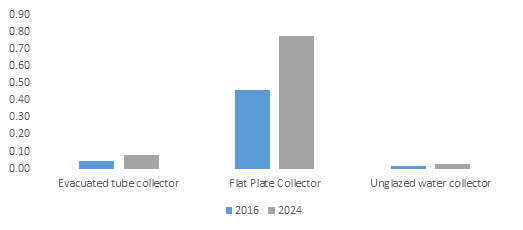Solar Water Heater Market to accrue remarkable proceeds over 2017-2024, initiatives undertaken by regional governments to embellish global industry progression
Publisher : Fractovia | Published Date : 2017-12-22Request Sample
Over the recent years, the rising inclination toward embracing renewable energy sources has been one of the most significant factors that have impelled solar water heater market share. The rapid upsurge in environmental concerns across developed and developing nations has led to tremendous efforts by government agencies and private firms to drastically slash greenhouse gas emissions, which has further embellished the growth prospects of solar water heater industry. Speaking in the similar context, a sizeable number of regional governments have been undertaking several initiatives to promote and encourage large-scale adoption of renewable energy systems for daily utilization. According to International Energy Agency’s flagship publication, World Energy Outlook 2016, solar water heater technology, owing to enhanced efficiency and reducing costs, has been expanding at a rate of 17 percent per year since 2000 and has been further forecast to account for the highest product demand over the forthcoming decades. Apparently, the aforementioned statements reinforce the favorable growth progression of the global solar water heater market share, which amassed a total revenue in excess of USD 2 billion in 2016, as per estimates.
Germany Solar Water Heater Market, By Collector, 2016 (GWth)

A brief outline of initiatives undertaken by regional governments and their impact on solar water heater market trends:
While elaborating further on the overall solar water heater industry landscape, it is quite essential to take note of the fact that developing nations are positioned to demonstrate more than 90 percent of the growth in global water heating demand over the ensuing 25 years, as per statistics released by International Energy Agency.
- In the recent times, the Indian government has been vigorously implementing a slew of measures to bolster the nation’s reliance on renewable energy sources. The Jawaharlal Nehru National Mission, a prominent initiative under the National Action Plan on Climate Change, aims to attain 100 GW of solar power generation capacity of India by 2022. As of now, the solar power generation capacity of the nation has accentuated by at least 5 times from 2,650 MW in 2014 to 12,288 MW in 2017. Needless to mention, the solar water heater industry players have a significant role to play in successfully implementing the mission.
- Touted to be the most expansive regional avenue in terms of deploying solar water heater systems, China solar water heater market size is anticipated to surpass a total installed capacity of about 45 GWth by 2024. If the recent news reports are to be believed, China’s National Energy Administration plans to allot a solar power installation quota which is said to be based on a re-evaluation of idle prices across the nation. The regulatory agency is reportedly in the process to slash quite a few quotas in the areas where the proportion of solar power curtailment is high. It has further decided upon some parameters such as local government services, land conditions, and success of particular regions in lowering clean-energy subsidies that would determine the volume of quota-reduction. Apparently, such measures are bound to encourage prominent solar water heater market giants to boost their efforts to launch efficient and effective solar water heating systems.
- Kenya’s Energy Regulatory Commission, in its efforts to promote wide-scale adoption of renewable energy, had announced that the solar water heating guidelines would be strictly enforced across the nation by the month of May in 2017. The guidelines prescribed under The Energy (Solar Water Heating) Regulations 2012, mandate installation of solar water heating systems across all premises, including large residential, commercial, and industrial complexes, that fall within the ambit of local municipal bodies. Post the deployment of these guidelines, the requirement of solar water heaters augmented at a commendable pace since 2012, as the regulator had provided with 5 years of grace period.
Apparently, the aforementioned instances of government measures to increase the renewable energy dependence is bound to have a positive impact on solar water heater industry outlook. As per a research study collated by Global Market Insights, Inc., solar water heater market is estimated to exceed USD 4 billion by 2024, in terms of remuneration.